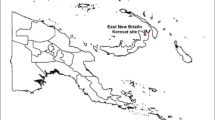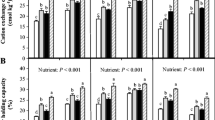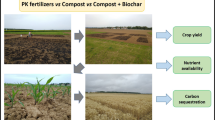Abstract
Soil amendments, such as compost and biochar are known to affect soil properties, soil microbial activity, and plant growth. These organic amendments have the ability to increase soil fertility, carbon sequestration, and crop productivity. However, there is limited information available on the integrated application of biochar and compost on microbial and enzymatic activity, nutrients availability and plant growth in arid soil. The present study was designed to quantify the effect of biochar along with compost on soil microbial biomass (carbon, nitrogen, phosphorus), enzyme (urease, alkaline phosphatase, dehydrogenase) activity, nutrients (N, P, K) availability in soil, and plant growth. The treatments comprise a control, biochar at 20 g kg−1 soil, compost at 20 g kg−1 soil, biochar + compost at (10 g kg−1 soil + 10 g kg−1 soil), biochar + compost at (15 g kg−1 soil + 5 g kg−1 soil), and biochar + compost at (5 g kg−1 soil + 15 g kg−1 soil). Tomato was grown as a test plant in the pot experiment. The results revealed that biochar and compost alone or in combinations proved statistically significant for Soil pH. Application of biochar at 20 g kg−1 soil proved useful and increased (130%) microbial biomass carbon (MBC) as compared with control. Compost at 20 g kg−1 soil increased alkaline phosphatase (143%), urease activity (10%) and plant nitrogen (33%) over control. However, microbial biomass nitrogen (MBN), and dehydrogenase activity increased by 62, and 100% respectively in the treatment receiving biochar and compost at 10 + 10 g kg−1 soil compared to that in the control. Plant phosphorus and potassium contents were 34 and 70% higher in the treatment receiving biochar and compost at 5 + 15 g kg−1 soil than in the control. However, for plant parameters (plant height, plant fresh weight, and plant dry weight), the combination of biochar and compost at 15 + 5 g kg−1 soil was superior to other treatments.



Similar content being viewed by others
References
Alef K, Nannipieri P (1995) Methods in applied soil microbiology and biochemistry. Academic Press, London
Brooks PC, Landman A, Pruden G, Jenkinson DS (1985) Chloroform fumigation and the release of soil nitrogen: a rapid direct extraction method to measure microbial biomass nitrogen in the soil. Soil Biol Biochem 17:837–842
Chan KY, Zwieten LV, Meszaros I, Downie A, Joseph S (2008) Using poultry litter biochar as soil amendments. Aus J Soil Res 46:437–444
Dempster DN, Gleeson DB, Solaiman ZM, Jones DL, Murphy DV (2011) Decreased soil microbial biomass and nitrogen mineralization with eucalyptus biochar addition to a coarse-textured soil. Geoderma 45:376–383
Elvazi F, Tabatabai MA (1977) Phosphatases in soil. Soil Biol Biochem 9:167–172
Galinato S, Yoder J, Granatstein D (2011) The economic value of biochar in crop production and carbon sequestration. Energy Policy 39:6344–6350
Jilani G, Akram A, Ali RM, Hafeez FY, Shamsi IH, Chaudhry AN, Chaudhry AG (2007) Enhancing crop growth, nutrients availability, economics and beneficial rhizosphere microflora through organic and bio fertilizers. Ann Microbial 57(2):177–183
Kandeler E, Gerber H (1988) Short-term assay of soil urease activity using colorimetric determination of ammonium. Biol Fert Soils 6:68–72
Kolb S (2007). Understanding the mechanisms by which manure based charcoal product affects microbial biomass and activity. Dissertation, University of Wisconsin
Lehmann J (2007) A handful of carbon. Nature 447(7141):143–144
Liang B, Lehmann J, Sohi SP, Thies JE, Neill BO, Trujillo L, Gaunt J, Solomon D, Grossman J, Neves EG, Luizao FJ (2010) Black carbon affects the cycling of non-black carbon in soil. Organic Geochem 41:206–213
Muhammad M, Darbandi EI, Rad HN, Tobeh A (2013) Growth and yield of tomato (Lycopersicon esculentum M) as influenced by different organic fertilizers. Intern J Plan Prod 4(4):734–738
Olsen SR, Cole CV, Watanabe FS, Dean LA (1954) Estimation of available phosphorus in soils by extraction with sodium bicarbonate. USDA, Cire. 939, U.S. Gover. Prin. Office, Washington DC
Page AL, Miller RH and Keeney DR (1982) Methods of soil analysis-chemical and microbiological properties. Part-2. SSSA and ASA Monograph No.9, Madison, Wisconsin, USA
Rhoades JD (1982) Cation exchange capacity. In Methods of soil analysis. Part 2. Chemical and microbiological properties (A.L. Page, R.H. Miller and D.R. Keeney), (Eds.) American Society of Agronomy, Inc. Soil Science Society of America. Inc., Madison, Wisconsin, pp 149–157
Steel RGL, Torrie TH (1997) Principles and procedures of statistics, 3rd edn. McGraw Hill Book Co., New York
Steiner C, Glaser B, Geraldes W, Lehmann TJ, Blum WEH, Zec W (2008) Nitrogen retention and plant uptake on a highly weathered central Amazonian Ferralsol amended with compost and charcoal. J Plant Nutr Soil Sci 171:893–899
Vendrell PF, Zupanicic J (1990) Determination of soil nitrate by transnitration of salicylic acid. Commun Soil Sci Plant Anal 21(13–16):1705–1713
Author information
Authors and Affiliations
Corresponding author
Additional information
This article is part of the Topical Collection on Implications of Biochar Application to Soil Environment under Arid Conditions
Rights and permissions
About this article
Cite this article
Akmal, M., Maqbool, Z., Khan, K.S. et al. Integrated use of biochar and compost to improve soil microbial activity, nutrient availability, and plant growth in arid soil. Arab J Geosci 12, 232 (2019). https://doi.org/10.1007/s12517-019-4414-0
Received:
Accepted:
Published:
DOI: https://doi.org/10.1007/s12517-019-4414-0




